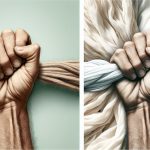You're probably noticing more brands emphasizing ethical sourcing practices and biodegradable fabrics in their collections. This shift isn't just a trend; it's a response to increasing consumer awareness and demand for eco-conscious products. Brands are adopting fair trade standards and transparent supply chains, while embracing materials like Tencel and hemp that minimize environmental impact. The slow fashion movement is also encouraging you to invest in timeless pieces over fast fashion. But that's not all—these trends are just the tip of the iceberg. Curious about how digital fashion and upcycling innovations are changing the landscape?
Table of Contents
Key Takeaways
- Emphasis on ethical sourcing ensures fair trade standards and supply chain transparency.
- Integration of biodegradable fabrics like Tencel and hemp reduces the fashion industry's environmental footprint.
- The slow fashion movement promotes quality over quantity with a focus on ethical production and timeless garments.
- Zero-waste production and circular fashion initiatives emphasize waste reduction, resource efficiency, and sustainable practices.
- Adoption of eco-friendly dyeing techniques such as waterless dyeing and plant-based colors minimizes environmental impact.
Ethical Sourcing Practices
Ethical sourcing practices ensure that the materials and labor used in fashion are both environmentally friendly and socially responsible. By adhering to fair trade standards, you guarantee that every step of the production process meets rigorous criteria. This means paying fair wages and providing safe working conditions, which directly support worker rights and sustainable livelihoods.
Supply chain transparency is critical in achieving these goals. When you can trace each component of your garment back to its origin, you have a clear picture of its environmental and social impact. Understanding where and how your materials are sourced allows you to make informed decisions that align with your sustainability values.
By prioritizing worker rights, you're not just improving lives; you're also securing the longevity and sustainability of the communities involved. When workers are treated fairly and paid adequately, they can invest in their futures, resulting in stable and thriving communities.
Adopting ethical sourcing practices isn't just good for the environment and society—it's also advantageous for your brand. Consumers increasingly demand transparency and responsibility in the products they buy, and meeting these expectations can set you apart in a competitive market.
Biodegradable Fabrics
You're probably aware that biodegradable fabrics offer a promising solution to reducing fashion's environmental impact. These innovative natural materials can break down more easily than traditional textiles, but the industry still faces challenges in widespread adoption.
Let's explore how these fabrics can revolutionize sustainability in fashion and address the obstacles ahead.
Innovative Natural Materials
In the domain of sustainable fashion, biodegradable textiles like Tencel and hemp are paving the way for a greener future. These plant-based fibers offer sustainable alternatives to traditional fabrics, reducing environmental impact while maintaining high-quality standards. Tencel, derived from wood pulp, is celebrated for its silky texture and minimal water usage during production. Hemp, on the other hand, is known for its durability and rapid growth cycle, making it an eco-friendly textile choice.
Innovative options in the market don't stop at Tencel and hemp. Other plant-based fibers such as bamboo and organic cotton are gaining popularity. These materials not only reduce reliance on synthetic fabrics but also promote sustainable farming practices. So, if you aim to master the art of sustainable fashion, integrating these textiles into your wardrobe is essential.
| Material | Characteristics | Benefits |
|---|---|---|
| Tencel | Soft, breathable | Low water usage |
| Hemp | Durable, fast-growing | Eco-friendly |
| Bamboo | Antibacterial, soft | Sustainable farming |
Environmental Impact Reduction
Building on the benefits of innovative natural materials, biodegradable fabrics greatly lessen the environmental footprint of the fashion industry. By choosing materials that break down naturally, you're contributing to a cycle that minimizes waste and pollution. These fabrics, derived from sustainable farming practices, ensure that the entire lifecycle of the garment—from growth to disposal—supports environmental health.
You're not just reducing the waste that ends up in landfills; you're also lowering the carbon footprint associated with production and disposal. Sustainable farming methods, such as organic cotton and hemp cultivation, use fewer resources and emit fewer greenhouse gases compared to conventional farming. This means the carbon emissions from your clothing choices are notably reduced.
Moreover, biodegradable fabrics often require less energy and water during the manufacturing process. By integrating these materials into your wardrobe, you're making a conscious effort to support a more sustainable fashion ecosystem.
Imagine the impact of widespread adoption: cleaner soils, reduced water contamination, and a marked decrease in synthetic microfibers polluting our oceans.
Incorporating biodegradable fabrics into your fashion choices isn't just a trend; it's a commitment to a more sustainable future.
Industry Adoption Challenges
Adopting biodegradable fabrics in the fashion industry faces significant challenges, from high production costs to limited consumer awareness. As an advocate for sustainable fashion, you must understand these hurdles to drive meaningful change. High costs deter small brands, making mass adoption difficult. Besides, consumers often lack education on the benefits of biodegradable fabrics, making it harder for brands to justify higher prices.
Brand transparency is essential. When brands clearly communicate their sustainable practices and provide verifiable information, they build trust and educate consumers. Sustainable certifications play a critical role here, ensuring that claims about biodegradable fabrics are credible.
Industry collaboration is another key factor. By working together, brands can share resources, reduce costs, and push for industry-wide standards, making sustainable options more accessible.
Here's a snapshot of the emotional landscape:
| Challenge | Impact on Consumers | Emotional Response |
|---|---|---|
| High Production Costs | Higher Product Prices | Frustration |
| Limited Awareness | Confusion | Uncertainty |
| Lack of Transparency | Distrust | Skepticism |
| Need for Collaboration | Slow Progress | Impatience |
| Certification Gaps | Doubt | Disillusionment |
To overcome these challenges, focus on consumer education and fostering industry collaboration. By doing so, you'll pave the way for a more sustainable fashion future.
Slow Fashion Movement
You'll appreciate the Slow Fashion Movement for its focus on ethical production practices and prioritizing quality over quantity.
It's about creating a timeless wardrobe with essentials that last, rather than chasing fleeting trends.
Ethical Production Practices
The Slow Fashion Movement emphasizes ethical production practices that prioritize quality, sustainability, and fair labor conditions over mass production.
When you support brands committed to fair trade, you guarantee that workers receive fair wages and work under humane conditions. Fair trade isn't just a label; it's a commitment to uphold rigorous labor standards that protect workers' rights and promote their well-being.
You also play a vital role in demanding supply chain transparency. By choosing brands that disclose their production processes, you hold them accountable. Transparency allows you to trace a garment's journey from raw materials to finished product, ensuring each step aligns with ethical standards. This accountability fosters trust and encourages brands to maintain high ethical standards.
Engaging with brands that prioritize these practices isn't merely a trend; it's a pivotal step toward a more sustainable and equitable fashion industry. Your choices drive industry changes, compelling companies to adopt more ethical practices.
Quality Over Quantity
When you embrace slow fashion, you champion quality over quantity, opting for timeless pieces crafted to last rather than succumbing to the fleeting allure of fast fashion. This sustainable style movement encourages you to invest in garments that aren't only well-made but also versatile. By doing so, you're not just making a fashion statement; you're committing to a minimalist approach that values durability and craftsmanship.
Opting for quality means you're likely to choose materials that are ethically sourced and environmentally friendly. You'll find that these pieces often feature meticulous stitching and thoughtful design, ensuring they withstand the test of time. This approach not only reduces waste but also curtails the constant cycle of consumption that fast fashion thrives on.
In the domain of sustainable style, less truly is more. By focusing on a minimalist approach, you streamline your wardrobe, making it easier to mix and match items for various occasions. This not only simplifies your life but also fosters a deeper appreciation for each piece you own. Ultimately, you're not just dressing better; you're making a conscious choice to support a more sustainable and thoughtful fashion ecosystem.
Timeless Wardrobe Essentials
While embracing the slow fashion movement, consider investing in timeless wardrobe essentials that offer both style and longevity. By focusing on minimalist essentials and sustainable accessories, you'll cultivate a closet that speaks to quality over quantity. Think classic pieces like a well-tailored blazer, versatile little black dress, and perfectly fitting jeans. These items transcend trends and become the backbone of your wardrobe.
A minimalist approach doesn't mean boring. It's about selecting items that are versatile and can be worn in multiple ways. For instance, a white button-up shirt can be dressed up with a statement necklace or down with a pair of sustainable sneakers. Investing in sustainable accessories, such as a durable leather belt or eco-friendly tote, enhances your outfits without compromising your values.
Here's a quick guide to essential pieces:
| Minimalist Essentials | Sustainable Accessories |
|---|---|
| White Button-Up Shirt | Eco-Friendly Tote |
| Little Black Dress | Recycled Material Belt |
| Well-Tailored Blazer | Sustainable Sneakers |
| Perfectly Fitting Jeans | Ethically Made Jewelry |
Upcycling Innovations
Upcycling innovations transform discarded materials into stylish and sustainable fashion items. By embracing creative upcycling and sustainable technology, you can turn waste into wearable art. This approach not only reduces landfill waste but also promotes a circular economy.
Utilizing artistic repurposing and eco-friendly design, designers and enthusiasts alike craft unique pieces that tell a story.
Consider these four innovative trends in upcycling:
- Denim Revamp: Transform old jeans into chic jackets or trendy bags. By cutting and re-stitching, you create new, fashionable items from worn-out denim.
- Patchwork Magic: Combine fabric scraps to make eye-catching patchwork garments. This method not only reduces textile waste but also results in one-of-a-kind designs.
- Accessory Reinvention: Repurpose broken jewelry or outdated accessories into modern pieces. With a bit of creativity, you can breathe new life into forgotten items.
- Furniture to Fashion: Convert old upholstery or curtains into stylish clothing. This not only extends the life of the fabric but also adds a unique touch to your wardrobe.
Digital Fashion Trends
Digital fashion trends are revolutionizing the industry by merging technology with innovative design. Imagine using virtual fitting and AR experiences to try on clothes without ever stepping into a store. By leveraging augmented reality, you can see how different outfits look on you in real-time. This not only enhances your shopping experience but also cuts down on returns, reducing waste and promoting sustainability.
Digital customization is another game-changer. It allows you to tailor garments to your exact preferences, from fabric choices to design elements, all through a user-friendly interface. This level of personalization guarantees that what you buy truly resonates with your style, making you less likely to discard items quickly.
Virtual closets are also transforming how you manage your wardrobe. Picture having a digital inventory of your clothes, accessible anytime, anywhere. This helps you make informed choices about new purchases and better utilize what you already own. You can mix and match outfits virtually, making sure that you make the most out of your existing collection before adding new pieces.
Zero-Waste Production
As digital fashion trends reshape the shopping experience, zero-waste production methods are transforming how clothes are made. You can now embrace fashion that doesn't contribute to landfill waste. Zero-waste production involves creating garments without any textile scraps. This means every inch of fabric is utilized through innovative pattern-making and cutting techniques.
To master zero-waste fashion, consider these key components:
- Creative Designs: Designers are getting more inventive, crafting patterns that fit together like puzzle pieces. This not only minimizes waste but also results in unique, eye-catching garments.
- Sustainable Packaging: Your commitment to sustainability doesn't stop at the clothes. Brands are also using recyclable and biodegradable materials for packaging, ensuring that every aspect of the product lifecycle is eco-friendly.
- Efficient Manufacturing: Traditional methods often waste fabric, but zero-waste techniques focus on precision. By optimizing fabric use, manufacturers reduce waste and costs, passing those savings on to you.
- Consumer Education: Brands are now educating you about zero-waste benefits, empowering you to make informed choices. Understanding the environmental impact of your purchases can help you support brands that align with your values.
Circular Fashion Economy
Imagine a world where your old clothes are given new life, seamlessly fitting into a system designed to eliminate fashion waste. That's the essence of the circular fashion economy.
In this innovative model, garments aren't just discarded but transformed, ensuring waste reduction and resource efficiency. You play an essential role by choosing brands that prioritize recycled materials and sustainable practices.
Instead of the traditional linear model of take-make-waste, the circular economy focuses on designing out waste and keeping products in use for as long as possible. When you buy a piece of clothing, think of it as an investment in a cycle that minimizes environmental impact.
Brands are now creating collections that can be easily disassembled, recycled, or upcycled, turning 'waste' into valuable resources.
Eco-Friendly Dyeing Techniques
Embracing eco-friendly dyeing methods can help lessen the environmental impact of your wardrobe. By adopting innovative approaches, you'll not only enhance the sustainability of your fashion choices but also contribute to a healthier planet.
- Waterless Dyeing: Traditional dyeing processes consume vast amounts of water, often resulting in pollution. Waterless dyeing methods, such as CO2 dyeing, eliminate water use entirely. This technique uses recycled carbon dioxide to infuse sustainable pigments into fabrics, drastically minimizing environmental harm.
- Plant-Based Colors: Harnessing natural dyes from plants provides an eco-conscious alternative to synthetic dyes. These colors are derived from sources like indigo, turmeric, and madder root. Plant-based colors not only reduce chemical use but also promote biodiversity.
- Sustainable Pigments: Opt for dyes made from non-toxic, biodegradable materials. Sustainable pigments, like those sourced from algae or fungi, offer vibrant hues without compromising ecological integrity. They break down naturally, preventing long-term environmental damage.
- Eco-Conscious Techniques: Methods like digital printing and cold pad batch dyeing greatly lower energy and water consumption. These eco-conscious techniques make sure that your garments retain their vibrancy while reducing their environmental footprint.
Frequently Asked Questions
How Can Consumers Verify if a Brand Is Truly Sustainable?
Did you know 60% of consumers struggle with greenwashing detection? Educate yourself on transparency standards and ethical sourcing. Verify brands by checking their certifications and reports, ensuring they meet rigorous sustainability criteria.
What Are the Benefits of Renting Clothes Instead of Buying?
You'll love renting clothes because it reduces your environmental impact, saves you money, and offers unparalleled convenience and variety. You can enjoy high-quality fashion without the commitment or clutter of buying new pieces.
How Does Sustainable Fashion Impact Garment Workers' Rights?
Sustainable fashion impacts garment workers' rights by ensuring fair wages and ethical practices. You'll see worker empowerment throughout the supply chain, fostering better working conditions and promoting dignity for those who create your clothing.
Are There Certifications to Look for When Buying Sustainable Clothing?
Yes, there are certifications you should look for. Prioritize labels like Fair Trade, GOTS for eco-friendly materials, and B Corp for transparency. These confirm ethical sourcing and guarantee your clothing adheres to high sustainability standards.
What Is the Role of Fashion Influencers in Promoting Sustainability?
Like a guiding light, fashion influencers shape your choices through influencer partnerships and ethical collaborations. Their social media impact promotes eco-friendly endorsements, encouraging you to make more sustainable decisions in your fashion purchases.
- How Does Ring Spun Cotton Affect Garment Fit and Shape Retention? - August 13, 2024
- What Are the Challenges in Producing Ring Spun Cotton? - August 13, 2024
- Is Ring Spun Cotton Suitable for Plus-Size Clothing? - August 13, 2024







